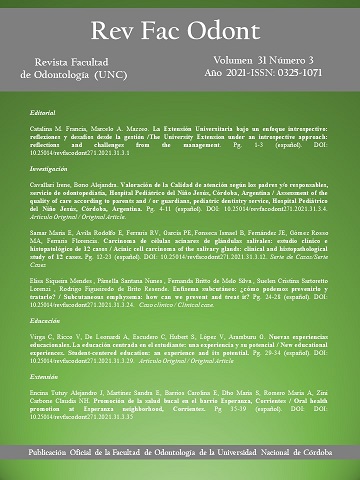New educational experiences. Student-centered education: an experience and its potential
Keywords:
Pharmacology, ICT, evaluation, meaningful learning, collaborative workAbstract
Introduction: The teaching of pharmacology has traditionally been characterized by the transmission of information where pedagogical strategies have focused on the teacher, privileging theoretical knowledge, master classes and memory tests. It is essential to introduce new elements to increase the student's active participation in the construction of knowledge and in the evaluation of the achievement of their competences; the development of creativity and teamwork. This methodology seeks to break the notion of traditional teaching, change the idea of an evaluation by the note to an evaluation with a motivation of its own (of the student), to internalize the knowledge and make it part of its structure of thought. Objective: Develop a teaching and evaluation strategy that allows students to actively participate. Materials and methods: 172 students participated in the subject of Pharmacology and Therapeutics "B", between March and September 2017. Four individual and complementary activities were developed related to the prescription of drugs, for the evaluation of the process and performance of the students Standardized rubrics were used, a perception survey was applied to the students about the usefulness of the strategy in their training. Results: The results show a good performance of the students in the prescription activities of medications, a significant improvement in the performance when comparing the results. The students consider that the strategy is useful for the development of their professional competences, it allows them to have an active role in the learning process and the evaluation methodology allows them to recognize the elements that they must reinforce in order to reach an optimal development of their competence.
References
1. Rodríguez-Carranza R, Vidrio H, Campos-Sepúlveda E. La enseñanza de la Farmacología en las escuelas de medicina. Situación actual y perspectivas. Rev. Medigrap Artemisa. 2008.
2. Resnick, L y Collins, A. Cognición y aprendizaje. Anuario de Psicologia, 1996; 69, 189-197.Disponible en: http://www.raco.cat/index.php/AnuarioPsicologia/article/viewFile/61324/88958
3. Conferencia Nacional de Decanos de Facultades de Medicina Españolas. Libro Blanco Titulación Medicina. 2005. Disponible en: http://www.med.uva.es/documentos/libro-blanco.pdf
4. Dubois E, Franson K, Bolk J, Cohen A. The impact of pre-clinical pharmacology and pharmacotherapy training on students' abilities and perceptions during clinical rotations. Medical Teacher, 2007; 29(9): 981-3.
5. Schellens JH, Grouls R, Guchelaar HJ, Touw DJ, Rongen GA, de Boer A, Van Bortel LM. The Dutch model for clinical pharmacology: collaboration between physician- and pharmacist—clinical pharmacologists. British Journal of Clinical Pharmacology, 2008; 66(1): 146-7.
6. Álvarez de Zayas CM. El diseño curricular en la escuela y análisis esencial del proceso curricular En: El diseño curricular. La Habana: Pueblo y Educación, 2001; p. 1-42.
7. Carreras J. Diseño de nuevos planes de estudios de medicina en el contexto del espacio europeo de educación superior. I.- Punto de partida y decisiones previas. Educación Médica, 2005; 8(4), Barcelona. Dec.Centre for Evidence Based Medicine. Evidence based medicine. Disponible desde internet en: http://www.cebm.net/index.aspx?o=1914.
8. Informe Final del Proyecto Tuning América Latina: Reflexiones y perspectivas de la Educación Superior en América Latina. 2007. Disponible en: http://tuning.unideusto.org/tuningal/index.php?option=com_docman&Itemid=191&task=view_category&catid=22&order=dmdate_published&ascdesc=DESC
9. Informe Final del Proyecto 6X4 UEALC. Propuestas y acciones universitarias para la transformaciónde la educación superior en América Latina. Medicina. 2008. Disponible en: http://www.6x4uealc.org/site2008/p01/16.pdf
10. Morales, P. y Landa V. Aprendizaje basado en problemas Problem – Based Learning. Theoria, 13:145-157. Disponible en: http://campus.usal.es/~ofeees/NUEVAS_METODOLOGIAS/ABP/13.pdf
11. Akici A, Gören MZ, Aypak C, Terzioglu B and Oktay S. Prescription audit adjunct to rationalpharmacotherapy education improves prescribing skills of medical students. European Journal ofClinical Pharmacology, 2005; 61(9): 643-50.
12. De Miguel Diaz, M. Modalidades de enseñanza centradas en el desarrollo de competencias. Ministerio de Educación y Ciencia. 2005. Ediciones Universidad de Oviedo.
13. Verdejo, P y Freixas R. Educación para el pensamiento complejo y competencias: Diseño de tareas y experiencias de aprendizaje. Documento de trabajo. 2008. Proyecto Innova Cesal.
14. González C, Sánchez L. El diseño curricular por competencias en la educación médica. Educación Medica Superior, 2003; 17(4). Disponible en: http://www.bvs.sld.cu/revistas/ems/vol17_4_03/suems403.htm Última consulta marzo 4 de 2010.
15. Likic R, Vitezic D, Maxwell S, Polasek O, Francetic I. The effects of problem-based learning integration in a course on rational drug use: a comparative study between two Croatian medical schools. European Journal of Clinical Pharmacology, 2009; 65(3): 231-7.
16. Cooke M., Irby D.M., Sullivan W., and Ludmerer K.M. American Medical Education 100 Years after the Flexner Report. New England Journal of Medicine, 355;13, 1339-1344.
17. Richir MC, Tichelaar J, Stanm F, Thijs A, Danner SA, Schneider AJ, de Vries TP. A context learning pharmacotherapy program for preclinical medical students leads to more rational drug prescribing during their clinical clerkship in internal medicine. Clinical Pharmacology Therapy, 2008; 84(4):13-6.
18. Organización Mundial de la Salud. Guía de la Buena Prescripción. OMS Programa de Acción sobre Medicamentos Esenciales, Ginebra, Suiza. 1994. Disponible en: http://www.ops.org.bo/textocompleto/ime500.pdf
Downloads
Published
Issue
Section
License

This work is licensed under a Creative Commons Attribution-NonCommercial-ShareAlike 4.0 International License.
Aquellos autores/as que tengan publicaciones con esta revista, aceptan los términos siguientes:
- Los autores/as conservarán sus derechos de autor y garantizarán a la revista el derecho de primera publicación de su obra, el cuál estará simultáneamente sujeto a la Licencia de reconocimiento de Creative Commons que permite a terceros:
- Compartir — copiar y redistribuir el material en cualquier medio o formato
- La licenciante no puede revocar estas libertades en tanto usted siga los términos de la licencia
- Los autores/as podrán adoptar otros acuerdos de licencia no exclusiva de distribución de la versión de la obra publicada (p. ej.: depositarla en un archivo telemático institucional o publicarla en un volumen monográfico) siempre que se indique la publicación inicial en esta revista.
- Se permite y recomienda a los autores/as difundir su obra a través de Internet (p. ej.: en archivos telemáticos institucionales o en su página web) después del su publicación en la revista, lo cual puede producir intercambios interesantes y aumentar las citas de la obra publicada. (Véase El efecto del acceso abierto).

